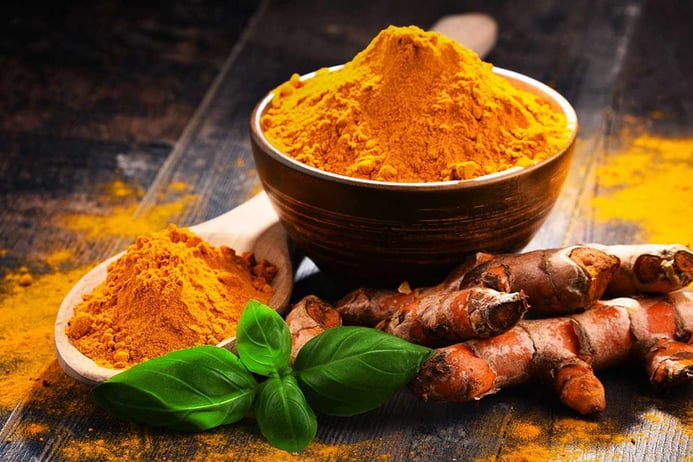Turmeric is a bright yellow spice obtained from the root of the ‘Curcuma longa’ plant. Originally from South Asia, turmeric has been used in both cooking and traditional medicine for millennia.
The history of turmeric
Turmeric’s history stretches back more than 4,000 years. It originated in South Asia, where it was used in Indian cuisine and Ayurvedic medicine. It was considered a sacred plant and was worshipped in religious ceremonies. It made its way to the Middle East and Europe (and later America) via trade routes, and was prized in these regions as an exotic spice and remedy. Today, turmeric enjoys worldwide renown as a superfood and is used for its health benefits as well as in the kitchen.
Turmeric’s nutritional values and constituents
Turmeric is not only an aromatic spice, but also rich in important nutrients.
These are its main constituents:
- Curcumin: the main bioactive ingredient that gives turmeric its characteristic yellow colour and a plethora of health benefits.
- Essential oils: these oils, including turmerone, atlantone and zingiberene, contribute to turmeric’s flavourful aroma and also have anti-inflammatory and antimicrobial properties.
- Fibre: turmeric is high in fibre, which promotes digestion and contributes to the health of the digestive system.
- Vitamins and minerals: turmeric contains significant amounts of vitamin C, vitamin E, potassium, iron and magnesium, all of which are important for overall health.
Turmeric is a versatile ingredient that not only adds colour and flavour to food, but also makes a valuable contribution to our daily nutrient intake.

Turmeric’s different forms
Turmeric comes in different forms, each of which has its own uses and benefits. Here’s an overview of the most common:
Turmeric powder
- This is the most commonly used form and is made by grinding the dried turmeric root.
- Best suited for everyday culinary use.
Fresh turmeric root
- The fresh root looks like ginger, but has a deep orangey-yellow colour.
- Delivers the most intense flavour and fresh nutrients.
Turmeric capsules
- Turmeric capsules contain highly concentrated curcumin, the active ingredient from the turmeric plant. This is often combined with piperine to improve absorption in the body.
- The capsules are taken orally and are ideal for people who want to enjoy the health benefits of turmeric without its intense flavour or the effort of preparing it.
Learn more about the different forms of turmeric here.

Health benefits of turmeric
Turmeric for inflammation:
Turmeric is widely known for its powerful anti-inflammatory properties, which are mainly due to its active ingredient curcumin. Curcumin has anti-inflammatory effects in several areas of the body by blocking certain molecules responsible for inflammation, such as cytokines and enzymes such as COX-2.
The antioxidant effect of turmeric:
Turmeric has strong antioxidant properties, which are mainly down to its active ingredient curcumin. Antioxidants are substances that protect the body from damage by free radicals, unstable molecules that can cause cell damage and are associated with the development of chronic diseases and the ageing process.
Turmeric for digestive health:
Turmeric has long been used to promote digestive health, especially in Ayurvedic and traditional Chinese medicine. The positive effects of turmeric on the digestive system are mainly due to its active ingredient curcumin and the essential oils contained in this root.
Turmeric for diseases:
There are also indications that turmeric could be beneficial in the prevention and treatment of illnesses such as circulatory diseases, arthritis and even certain cancers. Turmeric has additionally proven to be helpful in relieving joint pain and supporting the immune system. Many people use turmeric to promote brain health, too, as curcumin has neuroprotective properties that could potentially reduce the risk of neurodegenerative diseases such as Alzheimer’s.

Turmeric’s side effects and precautions to take
Turmeric – and especially its main ingredient curcumin – offers numerous health benefits. However, it is important to also be aware of possible side effects and precautions to take to ensure that it is used safely and effectively.
- Turmeric may trigger digestive problems.
- Allergic reactions may occur.
- Excessive consumption of turmeric may increase the risk of bleeding and bruising.
- Turmeric can interfere with the absorption of iron.
Always consult a doctor or health professional before consuming large amounts of turmeric or taking turmeric supplements, especially if you have any pre-existing health problems or conditions.
Turmeric in the kitchen
Turmeric is an incredibly versatile spice that’s used in traditional and modern recipes alike.
Traditional recipes using turmeric
- Turmeric is a main ingredient in many Indian curries, where it provides colour and flavour.

- An Ayurvedic dish made from rice and mung beans, often used to support the detoxification process.

- Turmeric is often used in pickled vegetables, which are served at almost every meal in India.

Modern recipes using turmeric
- A healthy smoothie that takes advantage of turmeric’s anti-inflammatory properties.
- A modern variant on classic hummus, with turmeric giving it a unique colour and taste.

- A nutrient-rich dish that combines quinoa with vegetables and turmeric.
Here are even more recipes with turmeric to try!
Turmeric in various cuisines around the world
Turmeric not only brings a beautiful golden colour to any dish: it also adds a rich flavour and all kinds of health benefits. Here are some examples of how turmeric is used around the globe.
Indian cuisine
- Curry
- Biriyani
- Kitchari
Thai cuisine
- Yellow Thai curry
- Tom Kha Gai
Moroccan cuisine
- Ras el hanout
- Lamb tagine
Golden turmeric milk
Golden turmeric milk, also known as a turmeric latte, is a popular drink loved for its health benefits and unique flavour. It has its roots in traditional Indian cuisine and has been used in Ayurveda for centuries to alleviate various ailments. In recent years, it has also gained popularity in Western wellness circles.
Try the golden turmeric milk recipe here!

Turmeric in cosmetics
Turmeric is becoming increasingly popular in cosmetics due to its host of skin benefits. The main constituents of turmeric, especially curcumin, offer numerous benefits – including anti-inflammatory, antioxidant and antibacterial properties – when used on the skin. Here are some ways that turmeric can be used in cosmetics:
- This mask can help to lighten the skin, improve its appearance and reduce congestion. Turmeric has antibacterial properties that can help combat acne and soothe the skin.
- This scrub removes dead skin cells and smoothes the complexion. Turmeric helps to soothe and nourish the skin.
Turmeric serum
- This serum can help to regenerate the skin, reduce wrinkles and enhance its appearance. The oils add hydration, while turmeric has an antioxidant effect.
- Adding turmeric to your bathwater can soothe and brighten the skin, while the milk or coconut milk moisturises and softens your skin.
Turmeric eye mask
- This mask can help reduce dark circles and soothe the delicate skin under your eyes.
Learn more about incorporating turmeric into your skincare routine here.

Growing turmeric
Turmeric (Curcuma longa) is a tropical plant that is mainly known for its roots (rhizomes), which are used in cooking and as a herbal remedy. Growing and harvesting turmeric requires specific conditions and techniques to achieve the best results.
The following factors play an important role in the cultivation of turmeric:
- Climatic conditions – temperature, humidity, light
- Soil quality – soil type, pH value
- Planting – planting turmeric at the right time
- Maintenance – irrigation, fertilisation, weed and pest control
Harvesting turmeric
When harvesting turmeric, it is important to pay heed to the following points:
- Harvest time – time of harvest, signs of ripening
- Harvesting process – harvesting, cleaning
- Post-processing – drying, processing
- Storage – store in a dry place
Turmeric’s health benefits only come to bear if it is harvested and processed properly.

Cultural and spiritual significance
Turmeric is not only important for its health benefits and culinary uses: it also plays an important role in various cultures and spiritual traditions. Here are some aspects of its cultural and spiritual significance:
Indian culture and Ayurveda
- Traditional use: turmeric has been a central component of Indian cuisine and traditional medicine (Ayurveda) for thousands of years. In Ayurveda, turmeric is referred to as “haridra” and is valued for its anti-inflammatory, antioxidant and cleansing properties.
- Ritual use: turmeric plays a role in many Hindu ceremonies. It is a symbol of purity and prosperity and is often used in religious rituals and wedding ceremonies. For example, a paste of turmeric, sandalwood and water is applied to the skin to cleanse and bless the body.
- Festivals and ceremonies: turmeric also features in festivals such as Diwali, the Festival of Light. It is used in festive meals and ceremonies.
Chinese medicine
- Use in traditional Chinese medicine (TCM): turmeric is referred to as “yujin” in Chinese medicine and is valued for its effect on energy flows in the body. It is used to treat the stagnation of vital energy (Qi) and to support the digestive system.
- Ritual meaning: as in India, turmeric also has a symbolic meaning in Chinese rituals and ceremonies. It is used to encourage wealth and health.

Turmeric’s sustainability credentials
Turmeric is of interest not only for its health benefits, but also for its sustainability credentials. The plant, which is primarily grown in tropical regions such as India, Indonesia and Sri Lanka, may have a positive impact on the environment and the agricultural system.
- Cultivation and soil health: turmeric is a robust plant that thrives in various soil types and is often used in crop rotation systems. By rotating the crops planted, the soil can maintain its fertility and pests are reduced. Turmeric does not require the intense use of fertilisers or pesticides, either, which reduces the use of chemicals and promotes soil health.
- Resource efficiency: turmeric requires a comparatively moderate amount of water, which is beneficial in regions where water is scarce. In addition, the plant often grows in small, integrated farming systems that require fewer resources than large-scale monocultures.
- Organic farming: in many regions, turmeric is increasingly grown in line with organic standards, further reducing the use of chemical fertilisers and pesticides. This helps preserve biodiversity and protects the ecosystem from harmful influences.
- Economic considerations: cultivating turmeric provides a source of income for many smallholders and contributes to the development of rural areas. The increasing demand for organically grown turmeric supports sustainable agricultural practices and promotes fair trade relations.
- Processing and transport: as with many agricultural products, the processing and transport of turmeric can have an impact on sustainability. Processing this root in the local area and shortening transport routes through regional production can reduce its carbon footprint.
All told, turmeric is a plant that can be grown under sustainable conditions and has the potential to contribute to an environmentally and socially responsible agricultural system. However, it is important that consumers pay heed to its origin and farming methods to ensure that they’re genuinely supporting sustainably produced products.

Known for its plethora of health benefits and cultural significance, turmeric is a fascinating spice that plays a central role in cooking and traditional medicine alike.
Kaufmännische Lernende





